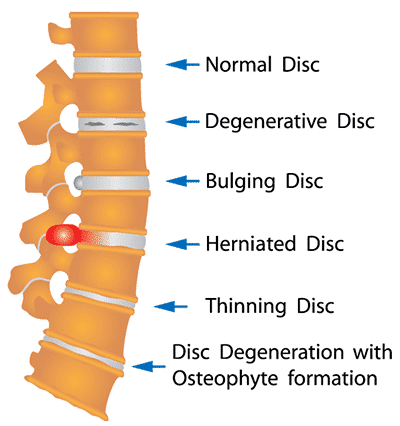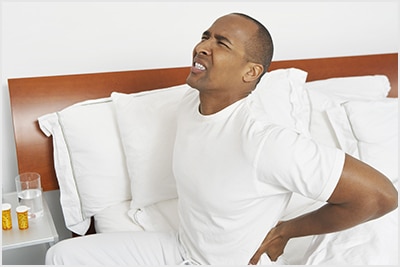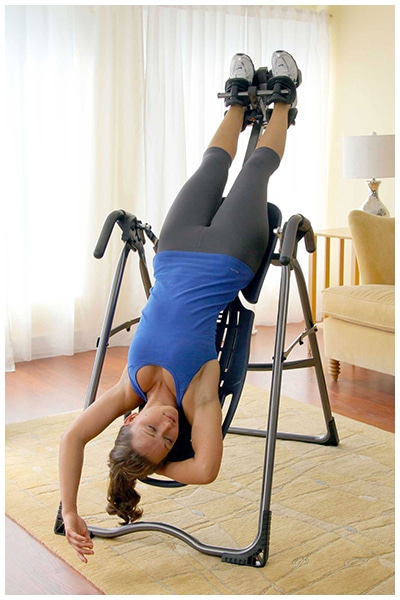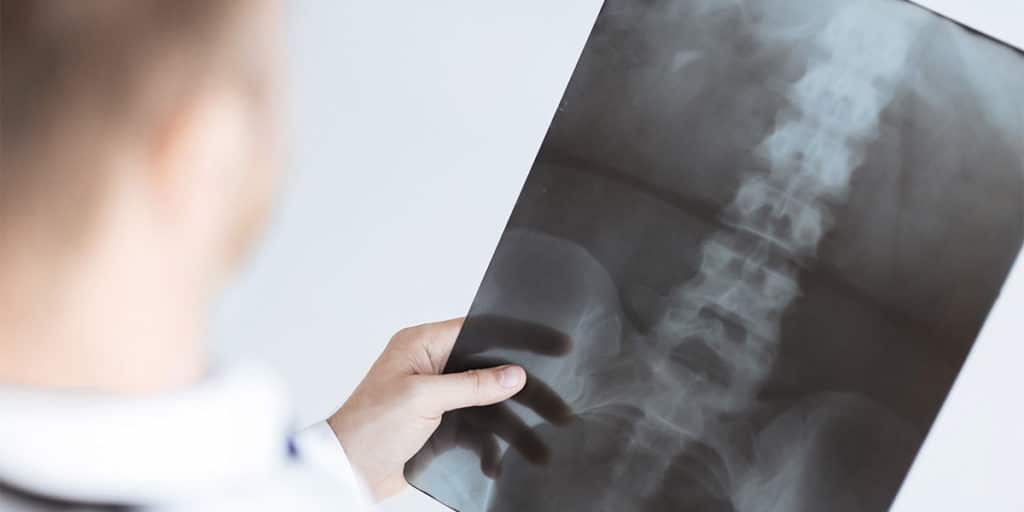What is Degenerative Disc Disease?
While the term ‘disease’ may sound alarming, it’s a misnomer.

The degeneration process occurs over time as a natural effect of aging and the compound effect of daily activities and compression on the spinal discs as they gradually lose volume and weaken. As we age, the discs in our spine naturally begin to decrease in size (lose water content), which causes the discs to lose their shock-absorbing capabilities and decreases the space between each vertebra. This can eventually lead to painful bone spurs and cause inflammation that irritates surrounding nerves that exit the spine between each vertebra.
How Does Degenerative Disc Disease Cause Pain?
Two primary factors stem from Degenerative Disc Disease that can cause pain:
Inflammation
As the discs decrease in size, there is less padding between vertebrae causing the spine to become less stable. As a result, painful bone spurs (bony growths) can form and place pressure on spinal nerve roots or the spinal cord. As a natural response, your body generates chemicals like histamine to increase blood flow to the area. The increase of chemicals can cause a leak of fluid that may leak into tissues. The resulting swelling can stimulate surrounding nerves and cause pain.1
In the lumbar disc space, pain from bone spurs and inflammation can radiate into the hips. The associated pain can also travel down the leg to cause the painful condition called Sciatica.
Abnormal Micro-Motion Instability
As the annulus (the outer rings of the intervertebral disc) wears down, it is no longer able to provide the proper support that the vertebrae need. Small movements, termed ‘micro-motion,’ may cause painful muscle spasms as your body attempts to stabilize the spine.
Symptoms of Degenerative Disc Disease
Though Degenerative Disc Disease affects individuals differently, there are several symptoms that many sufferers endure, including:

Severe episodes of pain that generally last from a few days to a few months before returning to a normal amount of pain;
Increased pain while sitting – the lumbar discs are loaded three times more than when standing, so additional pressure on the lumbar discs may excite the problem;
Bending, lifting, and twisting, which can make the pain unbearable for some.
Possible Solutions
Solutions to relieve Degenerative Disc Disease can vary depending on the severity of your symptoms and the amount of pain you are experiencing. Potential options range from surgical pain relief, prescription medication, exercise, lifestyle changes, and inverted decompression:
Surgery
There are two primary surgery options to remove a painful, degenerative disc: spinal fusion and disc replacement. A spinal fusion is a major surgery that joins two or more vertebrae through either a bone graft or metal implants to stabilize the spine. This encourages bone to grow between the vertebrae to fuse them. With an artificial disc replacement, the disc is completely removed and replaced with a prosthetic implant.
While surgery may be a necessary step for the most extreme conditions, there is a myriad of complications that stem from the general risks of surgery. It is generally advised that you try less-invasive, alternative options for at least 6 months before considering surgery due to the risk of complications, such as:
Pain at the bone graft site
Failure of the fusion, breakage of metal implants, or both
Allergic reaction to implant materials
Blood clots that may also lead to pulmonary embolism
Nerve injury
Graft rejection
Post-surgery pain or discomfort
Spinal fluid leak
Even if surgery is successful, there still is a chance that it doesn’t relieve the underlying cause of back pain! Since many forms of back pain stem from other stimuli like injury to a muscle or connective tissues, unfortunately, there is no guarantee that it will work to relieve your pain.
Prescription Drugs
Pain medications like anti-inflammatory NSAIDS can be effective for temporarily relieving pain, however, NSAIDs do not treat the underlying issue causing the pain. Therefore, they must be used daily to relieve symptoms, which has their own risks like increased chance of heart attack and stroke. Some studies have shown that high doses can have the opposite impact, making the body more sensitive to pain and increasing the risk of dependence.
Non-Invasive Rehabilitation
Most doctors agree that pursuing non-invasive solutions first, before surgery and a regimen of painkillers, is ideal to moderate risks. Exercise can strengthen the muscles surrounding the spine to help with stabilization. A more stable spine will help prevent further injury. Along with regular exercise, inverted decompression can help relieve the underlying sources of pain to help your body heal faster.
Inverted Decompression: A Natural, Non-Invasive Solution for Symptoms
Decompressing the space between the vertebrae is an ideal way to relieve pressure on degenerated discs to help them rejuvenate and rehydrate. Inversion therapy with a Teeter Inversion Table facilitates a natural form of decompression with the aid of your body weight and gravity. As the spine elongates and the space between the vertebrae increases, nutrients and fluids are introduced back into the disc, helping to make them more resilient to pressure and reducing inflammation.

In another study, data was collected from 778 cases of patients who had a diagnosis of degenerative disc, herniated disc, or facet syndrome and were treated with decompression therapy. Success was defined as a reduction in pain to a 0 or 1 when rated on a 0-5 scale, and the therapy was successful in 71% of the patients! 3
Researchers in yet another study noted the “potentially strong clinical implications in the treatment of low back problems of discogenic origin” in patients treated with gravity-facilitated traction (inversion therapy), noting increases in the space between the vertebrae as a key factor.4
Find Relief Now. Pay Later.
Now you can try Teeter in your own home FREE for 30-Days, 0% APR* with Affirm.
Choose Teeter to Relieve Symptoms of Degenerative Disc Disease
Teeter Inversion Tables help to naturally relieve back pain caused by multiple conditions of the spine, including Degenerative Disc Disease. In fact, Teeter is the only inversion table brand registered as a 510(k) medical device with the FDA. The Teeter is indicated for Degenerative Disc Disease, Sciatica, Herniated Discs, and 6 other causes of back pain.
Teeter is the leader of the industry with over 30 years of innovation and more than 3 million satisfied users.
